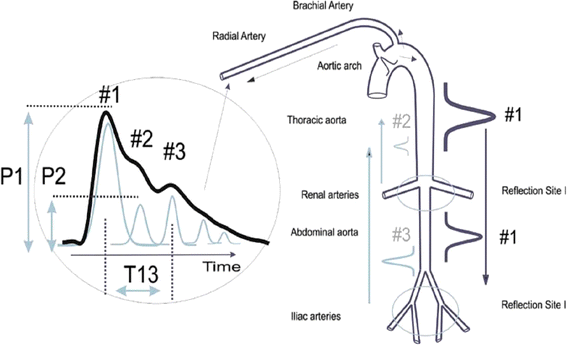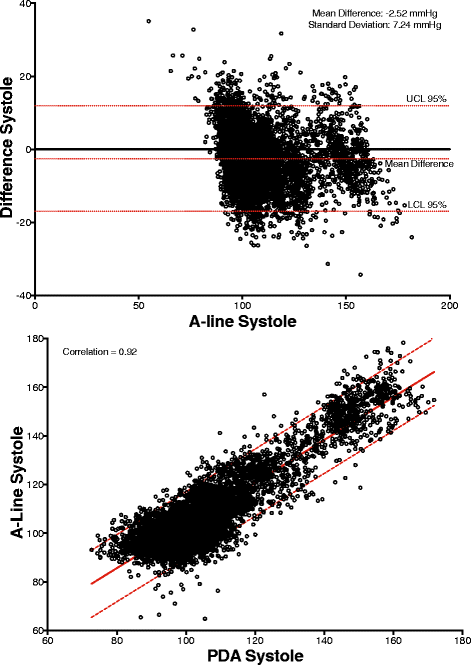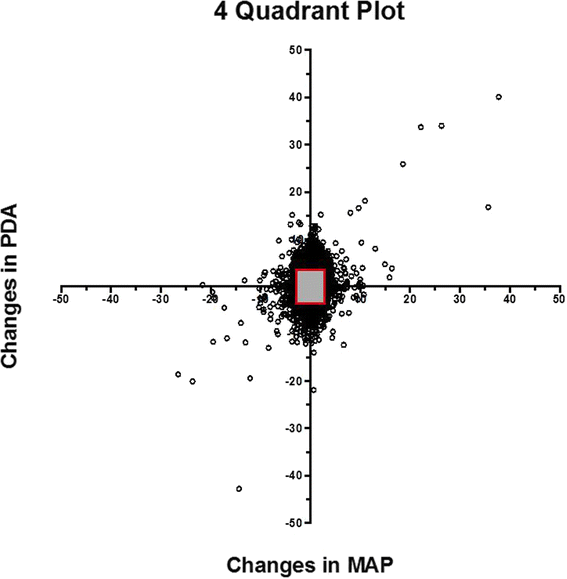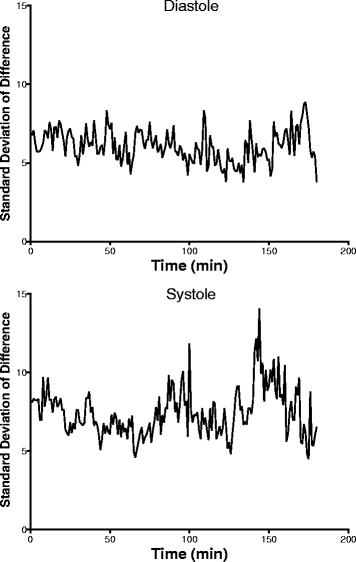Continuous Non-invasive finger cuff CareTaker® comparable to invasive intra-arterial pressure in patients undergoing major intra-abdominal surgery
- PMID: 28327093
- PMCID: PMC5361833
- DOI: 10.1186/s12871-017-0337-z
Continuous Non-invasive finger cuff CareTaker® comparable to invasive intra-arterial pressure in patients undergoing major intra-abdominal surgery
Abstract
Background: Despite increased interest in non-invasive arterial pressure monitoring, the majority of commercially available technologies have failed to satisfy the limits established for the validation of automatic arterial pressure monitoring by the Association for the Advancement of Medical Instrumentation (AAMI). According to the ANSI/AAMI/ISO 81060-2:2013 standards, the group-average accuracy and precision are defined as acceptable if bias is not greater than 5 mmHg and standard deviation is not greater than 8 mmHg. In this study, these standards are used to evaluate the CareTaker® (CT) device, a device measuring continuous non-invasive blood pressure via a pulse contour algorithm called Pulse Decomposition Analysis.
Methods: A convenience sample of 24 patients scheduled for major abdominal surgery were consented to participate in this IRB approved pilot study. Each patient was monitored with a radial arterial catheter and CT using a finger cuff applied to the contralateral thumb. Hemodynamic variables were measured and analyzed from both devices for the first thirty minutes of the surgical procedure including the induction of anesthesia. The mean arterial pressure (MAP), systolic and diastolic blood pressures continuously collected from the arterial catheter and CT were compared. Pearson correlation coefficients were calculated between arterial catheter and CT blood pressure measurements, a Bland-Altman analysis, and polar and 4Q plots were created.
Results: The correlation of systolic, diastolic, and mean arterial pressures were 0.92, 0.86, 0.91, respectively (p < 0.0001 for all the comparisons). The Bland-Altman comparison yielded a bias (as measured by overall mean difference) of -0.57, -2.52, 1.01 mmHg for systolic, diastolic, and mean arterial pressures, respectively with a standard deviation of 7.34, 6.47, 5.33 mmHg for systolic, diastolic, and mean arterial pressures, respectively (p < 0.001 for all comparisons). The polar plot indicates little bias between the two methods (90%/95% CI at 31.5°/52°, respectively, overall bias = 1.5°) with only a small percentage of points outside these lines. The 4Q plot indicates good concordance and no bias between the methods.
Conclusions: In this study, blood pressure measured using the non-invasive CT device was shown to correlate well with the arterial catheter measurements. Larger studies are needed to confirm these results in more varied settings. Most patients exhibited very good agreement between methods. Results were well within the limits established for the validation of automatic arterial pressure monitoring by the AAMI.
Keywords: CareTaker; Central blood pressure; Finger cuff; Intra-Arterial pressure; Non-Invasive.
Figures








Similar articles
-
Comparison of the ClearSight™ finger cuff monitor versus invasive arterial blood pressure measurement in elective cardiac surgery patients: a prospective observational study.Can J Anaesth. 2024 Nov;71(11):1495-1504. doi: 10.1007/s12630-024-02834-x. Epub 2024 Sep 24. Can J Anaesth. 2024. PMID: 39317830 English.
-
Comparison of non-invasive blood pressure monitoring using modified arterial applanation tonometry with intra-arterial measurement.J Clin Monit Comput. 2018 Feb;32(1):13-22. doi: 10.1007/s10877-017-9984-3. Epub 2017 Jan 19. J Clin Monit Comput. 2018. PMID: 28105538 Clinical Trial.
-
Level of agreement between Nexfin non-invasive arterial pressure with invasive arterial pressure measurements in children.Br J Anaesth. 2012 Oct;109(4):609-15. doi: 10.1093/bja/aes295. Epub 2012 Aug 19. Br J Anaesth. 2012. PMID: 22907342
-
Continuous noninvasive pulse wave analysis using finger cuff technologies for arterial blood pressure and cardiac output monitoring in perioperative and intensive care medicine: a systematic review and meta-analysis.Br J Anaesth. 2020 Jul;125(1):25-37. doi: 10.1016/j.bja.2020.03.013. Epub 2020 May 29. Br J Anaesth. 2020. PMID: 32475686
-
The accuracy of noninvasive cardiac output and pressure measurements with finger cuff: a concise review.Curr Opin Crit Care. 2015 Jun;21(3):232-9. doi: 10.1097/MCC.0000000000000198. Curr Opin Crit Care. 2015. PMID: 25922896 Review.
Cited by
-
A Review of Skin-Wearable Sensors for Non-Invasive Health Monitoring Applications.Sensors (Basel). 2023 Mar 31;23(7):3673. doi: 10.3390/s23073673. Sensors (Basel). 2023. PMID: 37050733 Free PMC article. Review.
-
D-dimer in Marfan syndrome: effect of obstructive sleep apnea induced blood pressure surges.Am J Physiol Heart Circ Physiol. 2022 May 1;322(5):H742-H748. doi: 10.1152/ajpheart.00004.2022. Epub 2022 Mar 11. Am J Physiol Heart Circ Physiol. 2022. PMID: 35275761 Free PMC article. Clinical Trial.
-
Short-term blood pressure variability and brain functional network connectivity in older adults.Neuroimage Rep. 2024 Mar;4(1):100198. doi: 10.1016/j.ynirp.2024.100198. Epub 2024 Feb 14. Neuroimage Rep. 2024. PMID: 38699510 Free PMC article.
-
Cuffless Blood Pressure Monitor for Home and Hospital Use.Sensors (Basel). 2025 Jan 22;25(3):640. doi: 10.3390/s25030640. Sensors (Basel). 2025. PMID: 39943278 Free PMC article. Review.
-
Non-invasive haemodynamic monitoring with Clearsight in patients undergoing spinal anaesthesia for total hip replacement. A prospective observational cohort study.Acta Biomed. 2020 Nov 10;91(4):e2020182. doi: 10.23750/abm.v91i4.8665. Acta Biomed. 2020. PMID: 33525276 Free PMC article.
References
-
- Kim SH, Lilot M, Sidhu KS, Rinehart J, Yu Z, Canales C, Cannesson M. Accuracy and precision of continuous noninvasive arterial pressure monitoring compared with invasive arterial pressure: a systematic review and meta-analysis. Anesthesiology. 2014;120(5):1080–97. doi: 10.1097/ALN.0000000000000226. - DOI - PubMed
-
- Nichols WW, O’Rourke MF, McDonald’s blood flow in arteries . Theoretical, experimental and clinical principles. London: Edward Arnold; 1999.
Publication types
MeSH terms
Grants and funding
LinkOut - more resources
Full Text Sources
Other Literature Sources
Medical

